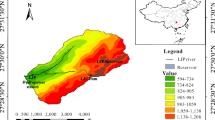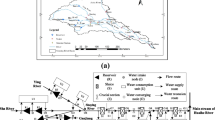Abstract
A novel ecological operation chart and coordinated management policy for the cascaded hydropower system are proposed in this study, in which limited ecological curves were introduced to balance long- and short-term ecological requirements and hydropower benefits. A case study is performed in Xiaowan-Manwan reservoirs on the Lancang River. The proposed operation charts lead to a 0.77% increase in electric production and a 0.05% increase in ecological conservation degree, as well as alleviation in the ecological damage frequency from 19.72 to 10.28%. The operation strategy and management policy are further discussed including trade-offs among competing objectives, monitoring, an early warning system, and the multiparty platform in practical operation.









Similar content being viewed by others
References
Bovee KD, Milhous RT (1978) Hydraulic simulation in instream flow studies: theory and techniques. In: Instream Flow Information Paper 5. U.S. Fish & Wildlife Service Biological Report. p 130
Bovee KD (1982) A guide to stream habitat analysis using the instream flow incremental methodology Reports 2:19–28
Bovee KD (1986) Development of habitat suitability criteria for use in the instream flow incremental methodology Usgs Fort Collins Science Center 86
Chen Q, Chen D, Li R et al (2013) Adapting the operation of two cascaded reservoirs for ecological flow requirement of a de-watered river channel due to diversion-type hydropower stations. Ecol Model 252:266–272. https://doi.org/10.1016/j.ecolmodel.2012.03.008
Ding ZY, Fang GH, Wen X et al (2018) A novel operation chart for cascade hydropower system to alleviate ecological degradation in hydrological extremes. Ecol Model 384:10–22. https://doi.org/10.1016/j.ecolmodel.2018.05.025
Fang G, Guo Y, Wen X et al. (2018) Multi-objective differential evolution-chaos shuffled frog leaping algorithm for water resources system optimization water resources management An International Journal Published for the European Water Resources Association 32:3835-3852
Garcia A, Jorde K, Habit E et al (2011) Downstream environmental effects of dam operations: changes in habitat quality for native fish species. River Res Appl 27:312–327. https://doi.org/10.1002/rra.1358
Gibbins CN, Soulsby C, Jeffries MJ et al (2010) Developing ecologically acceptable river flow regimes: a case study of Kielder reservoir and the Kielder water transfer system. Fish Manage Ecol 8:463–485
Hossain MS, El-shafie A (2013) Intelligent systems in optimizing reservoir operation policy: a review. Water Resour Manag 27:3387–3407. https://doi.org/10.1007/s11269-013-0353-9
Jiang ZQ, Liu P, Ji CM et al. (2019) Ecological flow considered multi-objective storage energy operation chart optimization of large-scale mixed reservoirs. J Hydrol 577. https://doi.org/10.1016/j.jhydrol.2019.123949
Kuriqi A, Pinheiro AN, Sordo-Ward A et al (2020) Water-energy-ecosystem nexus: balancing competing interests at a run-of-river hydropower plant coupling a hydrologic-ecohydraulic approach. Energy Convers Manag 223. https://doi.org/10.1016/j.enconman.2020.113267
Li X, Cui W, Guo Y et al (2022) Research and application for drawing method of multilevel reservoir operation chart. J Tianjin Univ 55:322–330
Melack JM, Coe MT (2021) Amazon floodplain hydrology and implications for aquatic conservation 31:1029-1040
Moir HJ, Gibbins CN, Soulsby C et al (2005) PHABSIM modelling of Atlantic salmon spawning habitat in an upland stream: testing the influence of habitat suitability indices on model output. River Res Appl 21:1021–1034. https://doi.org/10.1002/rra.869
Nagaya T, Shiraishi Y, Onitsuka K et al (2008) Evaluation of suitable hydraulic conditions for spawning of ayu with horizontal 2D numerical simulation and PHABSIM. Ecol Modell 215:133–143. https://doi.org/10.1016/j.ecolmodel.2008.02.043
Opan M (2010) Irrigation-energy management using a DPSA-based optimization model in the Ceyhan Basin of Turkey. J Hydrol 385:353–360. https://doi.org/10.1016/j.jhydrol.2010.03.003
Reich P, Lake PS (2015) Extreme hydrological events and the ecological restoration of flowing waters. Freshw Biol 60:2639–2652. https://doi.org/10.1111/fwb.12508
Silva AT, Baerum KM, Hedger RD et al (2020) The effects of hydrodynamics on the three-dimensional downstream migratory movement of Atlantic salmon. Sci Total Environ 705:10. https://doi.org/10.1016/j.scitotenv.2019.135773
Song JH, Her Y, Shin S et al (2020) Evaluating the performance of climate models in reproducing the hydrological characteristics of rainfall events. Hydrol Sci J-J Sci Hydrol 65:1490–1511. https://doi.org/10.1080/02626667.2020.1750616
Sun XS, Wang XG, Liu LP et al (2019) Development and present situation of hydropower in China. Water Policy 21:565-581. https://doi.org/10.2166/wp.2019.206
Tharme RE (2003) A global perspective on environmental flow assessment: emerging trends in the development and application of environmental flow methodologies for rivers. River Res Appl 19:397–441. https://doi.org/10.1002/rra.736
van Kempen G, van der Wiel K, Melsen LA (2021) The impact of hydrological model structure on the simulation of extreme runoff events. Nat Hazards Earth Syst Sci 21:961–976. https://doi.org/10.5194/nhes-21-961-2021
Wang X, Lei X, Jiang Y et al (2013) Reservoir operation chart optimization searching in feasible region based on genetic algorithms. J Hydraul Eng 44:26–34
Wang C, Yu Y, Wang PF et al (2016) Assessment of the ecological reservoir operation in the Yangtze Estuary based on the salinity requirements of the indicator species. River Res Appl 32:946–957. https://doi.org/10.1002/rra.2912
Wen X, Fang GH, Guo YX et al (2016) Adapting the operation of cascaded reservoirs on Yuan River for fish habitat conservation. Ecol Model 337:221–230
Wen X, Liu Z, Lei X et al (2018) Future changes in Yuan River ecohydrology: individual and cumulative impacts of climates change and cascade hydropower development on runoff and aquatic habitat quality. Sci Total Environ 633:1403
Yi Y, Tang C, Yang Z et al (2014) Influence of Manwan Reservoir on fish habitat in the middle reach of the Lancang River. Ecol Eng 69:106–117
Yu Y, Wang PF, Wang C et al (2017) Combined Monthly inflow forecasting and multiobjective ecological reservoir operations model: case study of the three gorges reservoir. J Water Resour Plan Manag 143:13. https://doi.org/10.1061/(asce)wr.1943-5452.0000786
Zhang W, Liu P, Chen X et al (2015) Optimal operation of multi-reservoir systems considering time-lags of flood routing. Water Resour Manag 30:523–540. https://doi.org/10.1007/s11269-015-1175-8
Zhao TTG, Zhao JS, Yang DW (2014) Improved dynamic programming for hydropower reservoir operation. J Water Resour Plan Manage-ASCE 140:365–374. https://doi.org/10.1061/(asce)wr.1943-5452.0000343
Zhou Y, Guo S (2013) Incorporating ecological requirement into multipurpose reservoir operating rule curves for adaptation to climate change. J Hydrol 498:153–164
Acknowledgements
This research is funded by the National Natural Science Foundation of China (52079040), Jiangsu Water Science and Technology Project (2019027, 2020065). This paper is also supported by the High-Performance Computing Platform of Hohai University, China.
Author information
Authors and Affiliations
Corresponding author
Ethics declarations
Conflict of interest
The authors declare no competing interests.
Additional information
Responsible Editor: Broder J. Merkel
Rights and permissions
About this article
Cite this article
Xue, L., Wen, X., Su, H. et al. A novel operation rule and policy of a multi-reservoir system on the Lancang River to balance ecological requirements and hydropower benefits. Arab J Geosci 15, 1326 (2022). https://doi.org/10.1007/s12517-022-10571-y
Received:
Accepted:
Published:
DOI: https://doi.org/10.1007/s12517-022-10571-y




